Snake scale
Snakes, like other reptiles, have skin covered in scales.[1] Snakes are entirely covered with scales or scutes of various shapes and sizes, known as snakeskin as a whole. A scale protects the body of the snake, aids it in locomotion, allows moisture to be retained within, alters the surface characteristics such as roughness to aid in camouflage, and in some cases even aids in prey capture (such as Acrochordus). The simple or complex colouration patterns (which help in camouflage and anti-predator display) are a property of the underlying skin, but the folded nature of scaled skin allows bright skin to be concealed between scales then revealed in order to startle predators.
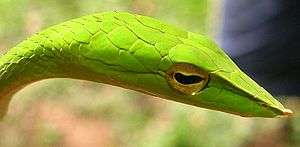
Scales have been modified over time to serve other functions such as 'eyelash' fringes, and protective covers for the eyes[2] with the most distinctive modification being the rattle of the North American rattlesnakes.
Snakes periodically moult their scaly skins and acquire new ones. This permits replacement of old worn out skin, disposal of parasites and is thought to allow the snake to grow. The arrangement of scales is used to identify snake species.
Snakes have been part and parcel of culture and religion. Vivid scale patterns have been thought to have influenced early art. The use of snake-skin in manufacture of purses, apparel and other articles led to large-scale killing of snakes, giving rise to advocacy for use of artificial snake-skin. Snake scales are also to be found as motifs in fiction, art and films.
Functions of scales
The scales of a snake primarily serve to reduce friction as it moves, since friction is the major source of energy loss in snake locomotion.
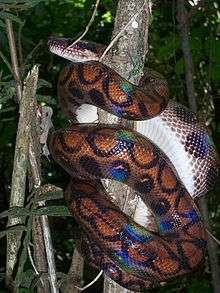
The ventral (or belly) scales, which are large and oblong, are especially low-friction, and some arboreal species can use the edges to grip branches. Snake skin and scales help retain moisture in the animal's body.[3] Snakes pick up vibrations from both the air and the ground, and can differentiate the two, using a complex system of internal resonances (perhaps involving the scales).[4]
Evolution
Reptiles evolved from amphibious ancestors which left the aquatic lifestyle and became terrestrial. To prevent loss of moisture reptilian skin lost the softness and moisture of amphibian skin and developing a thick stratum corneum with multiple layers of lipids which served as an impermeable barrier as well as provided protection from the ultraviolet.[5] Over time, reptilian skin cells became highly keratinised, horny, sturdy and desiccated. The surfaces of the dermis and epidermis of all reptilian scales form a single contiguous sheet, as can be seen when the snake sheds its skin as a whole.[6]
Morphology of scales
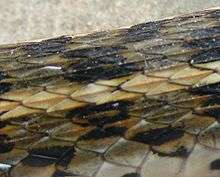
Snake scales are formed by the differentiation of the snake's underlying skin or epidermis.[7] Each scale has an outer surface and an inner surface. The skin from the inner surface hinges back and forms a free area which overlaps the base of the next scale which emerges below this scale.[8] A snake hatches with a fixed number of scales. The scales do not increase in number as the snake matures nor do they reduce in number over time. The scales however grow larger in size and may change shape with each moult.[9]
Snakes have smaller scales around the mouth and sides of the body which allow expansion so that a snake can consume prey of much larger width than itself. Snake scales are made of keratin, the same material that hair and fingernails are made of.[9] They are cool and dry to touch.[10]
Surface and shape
Snake scales are of different shapes and sizes. Snake scales may be granular, have a smooth surface or have a longitudinal ridge or keel on it. Often, snake scales have pits, tubercles and other fine structures which may be visible to the naked eye or under a microscope. Snake scales may be modified to form fringes, as in the case of the eyelash bush viper, Atheris ceratophora, or rattles as in the case of the rattlesnakes of North America.[8]
Certain primitive snakes such as boas, pythons and certain advanced snakes such as vipers have small scales arranged irregularly on the head. Other more advanced snakes have special large symmetrical scales on the head called shields or plates.[8]
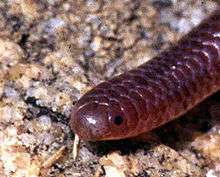
Snake scales occur in variety of shapes. They may be cycloid as in family Typhlopidae,[11] long and pointed with pointed tips, as in the case of the green vine snake Ahaetulla nasuta,[12] broad and leaf-like, as in the case of green pit vipers Trimeresurus spp.[12] or as broad as they are long, for example, as in rat snake Ptyas mucosus.[12] In some cases, scales may be keeled weakly or strongly as in the case of the buff-striped keelback Amphiesma stolatum.[12] They may have bidentate tips as in some spp of Natrix.[12] Some snakes, such as the short seasnake Lapemis curtus, may have spinelike and juxtaposed scales[8] while others may have large and non-overlapping knobs as in the case of the Javan mudsnake Xenodermus javanicus.[8]
Another example of differentiation of snake scales is a transparent scale called the brille or spectacle which covers the eye of the snake. The brille is often referred to as a fused eyelid. It is shed as part of the old skin during moulting.[2]
Rattles
The most distinctive modification of the snake scale is the rattle of rattlesnakes, such as those of the genera Crotalus and Sistrurus. The rattle is made up of a series of loosely linked, interlocking chambers that when shaken, vibrate against one another to create the warning signal of a rattlesnake. Only the bottom is firmly attached to the tip of the tail.[13]
At birth, a rattlesnake hatchling has only a small button or 'primordial rattle' which is firmly attached to the tip of the tail.[13] The first segment is added when the hatchling sheds its skin for the first time.[14] A new section is added each time the skin is shed until a rattle is formed. The rattle grows as the snake ages but segments are also prone to breaking off and hence the length of a rattle is not a reliable indicator of the age of a snake.[15]
Colour
Scales mostly consist of hard beta keratins which are basically transparent. The colours of the scale are due to pigments in the inner layers of the skin and not due to the scale material itself. Scales are hued for all colours in this manner except for blue and green. Blue is caused by the ultrastructure of the scales. By itself, such a scale surface diffracts light and gives a blue hue, while, in combination with yellow from the inner skin it gives a beautiful iridescent green.
Some snakes have the ability to change the hue of their scales slowly. This is typically seen in cases where the snake becomes lighter or darker with change in season. In some cases, this change may take place between day and night.[9]
Ecdysis
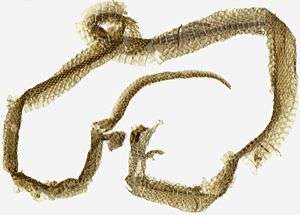
The shedding of scales is called ecdysis, or, in normal usage moulting or sloughing. In the case of snakes, the complete outer layer of skin is shed in one layer.[16] Snake scales are not discrete but extensions of the epidermis hence they are not shed separately, but are ejected as a complete contiguous outer layer of skin during each moult, akin to a sock being turned inside out.[9]
Moulting serves a number of functions – firstly, the old and worn skin is replaced, secondly, it helps get rid of parasites such as mites and ticks. Renewal of the skin by moulting is supposed to allow growth in some animals such as insects, however this view has been disputed in the case of snakes.[9][17]
Moulting is repeated periodically throughout a snake's life. Before a moult, the snake stops eating and often hides or moves to a safe place. Just before shedding, the skin becomes dull and dry looking and the eyes become cloudy or blue-colored. The inner surface of the old outer skin liquefies. This causes the old outer skin to separate from the new inner skin. After a few days, the eyes clear and the snake "crawls" out of its old skin. The old skin breaks near the mouth and the snake wriggles out aided by rubbing against rough surfaces. In many cases the cast skin peels backward over the body from head to tail, in one piece like an old sock. A new, larger, and brighter layer of skin has formed underneath.[9][18]
An older snake may shed its skin only once or twice a year, but a younger, still-growing snake, may shed up to four times a year.[18] The discarded skin gives a perfect imprint of the scale pattern and it is usually possible to identify the snake if this discard is reasonably complete and intact.[9]
Arrangement of scales
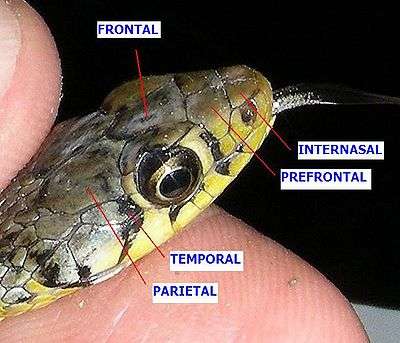
Scale arrangements are important, not only for taxonomic utility, but also for forensic reasons and conservation of snake species.[19] Excepting for the head, snakes have imbricate scales, overlapping like the tiles on a roof.[20] Snakes have rows of scales along the whole or part of their length and also many other specialised scales, either singly or in pairs, occurring on the head and other regions of the body.
The dorsal (or body) scales on the snake's body are arranged in rows along the length of their bodies. Adjacent rows are diagonally offset from each other. Most snakes have an odd number of rows across the body though certain species have an even number of rows e.g. Zaocys spp.[8] In the case of some aquatic and marine snakes, the scales are granular and the rows cannot be counted.[20]
The number of rows range from ten in Tiger Ratsnake Spilotes pullatus; thirteen in Dryocalamus, Liopeltis, Calamaria and Asian coral snakes of genus Calliophis; 65 to 75 in pythons; 74 to 93 in Kolpophis and 130 to 150 in Acrochordus. The majority of the largest family of snakes, the Colubridae have 15, 17 or 19 rows of scales.[8][21] The maximum number of rows are in mid-body and they reduce in count towards the head and on the tail.
Nomenclature of scales
The various scales on a snake's head and body are indicated in the following paragraphs with annotated photographs of Buff-striped Keelback Amphiesma stolata, a common grass-snake of South Asia and a member of Colubridae, the largest snake family.
Head scales
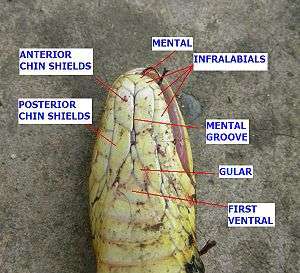
Identification of cephalic scales is most conveniently begun with reference to the nostril, which is easily identified on a snake. There are two scales enclosing the nostril which are called the nasals. In colubrids, the nostril lies between the nasals, while in vipers it lies in the centre of a single nasal scale.[22] The outer nasal (near the snout) is called the prenasal while the inner nasal (near the eye) is called the postnasal. Along the top of the snout connecting the nasals on both sides of the head are scales called internasals. Between the two prenasals is a scale at the tip of the snout called the rostral scale.[22]
The scales around the eye are called circumorbital scales and are named as ocular scales but with appropriate prefixes. The ocular scale proper is a transparent scale covering the eye which is called the spectacle, brille or eyecap.[9][23] The circumorbital scales towards the snout or the front are called preocular scales, those towards the rear are called postocular scales, and those towards the upper or dorsal side are called supraocular scales. Circumorbital scales towards the ventral or lower side, if any, are called subocular scales. Between the preocular and the postnasal scales are one or two scales called loreal scales.[22] Loreal scales are absent in elapids.
The scales along the lips of the snake are called labials. Those on the upper lip are called supralabials or upper labials, while those on the lower lip are called infralabials or lower labials. On top of the head, between the eyes, adjacent to the supraoculars is the frontal scale. The prefrontal scales are the scales connected to the frontal towards the tip of the snout which are in contact with the internasals. They may have a scale in between them.[22] The back of the top of the head has scales connected to the frontal scale called the parietal scales. At the sides of the back of the head between the parietals above and the supralabials below are scales called temporal scales.[22]
On the underside of the head, a snake has an anterior scale called the mental scale. Connected to the mental scale and all along the lower lips are the infralabials or lower labials. Along the chin connected to the infralabials is a pair of shields called the anterior chin shields. Next to the anterior chin shields, further back along the chin is another pair of shields called the posterior chin shields. In some texts the chinshields are referred to as submaxillary scales.[22]
Scales in the central or throat region, which are in contact with the first ventral scales of a snake's body and are flanked by the chin shields, are called gular scales. The mental groove is a longitudinal groove on the underside of the head between the large, paired chin shields and continuing between the smaller gular scales.
Body scales
The scales on the body of the snake are called the dorsal or costal scales. Sometimes there is a special row of large scales along the top of the back of the snake, i.e., the uppermost row, called the vertebral scales. The enlarged scales on the belly of the snake are called ventral scales or gastrosteges. The number of ventral scales can be a guide to the species.[22] In "advanced" (Caenophidian) snakes, the broad belly scales and rows of dorsal scales correspond to the vertebrae, allowing scientists to count the vertebrae without dissection.
Tail scales
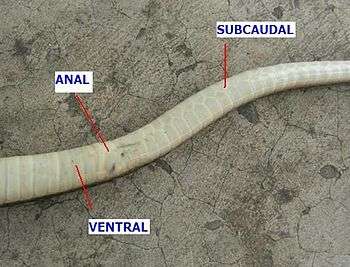
At the end of the ventral scales of the snake is an anal plate that protects the opening to the cloaca (a shared opening for waste and reproductive material to pass) on the underside near the tail. This anal scale may be single or divided into a pair. The part of the body beyond the anal scale is considered to be the tail.[13]
Sometimes snakes have enlarged scales, either single or paired, under the tail; these are called subcaudals or urosteges.[22] These subcaudals may be smooth or keeled as in Bitis arietans somalica. The end of the tail may simply taper into a tip (as in the case of most snakes), it may form a spine (as in Acanthophis), end in a bony spur (as in Lachesis), a rattle (as in Crotalus), or a rudder as seen in many sea snakes.
Sources. Details for this section have been sourced from scale diagrams in Malcolm Smith.[24] Details of scales of Buff-striped Keelback have been taken from Daniels.[25]
Glossary of scales
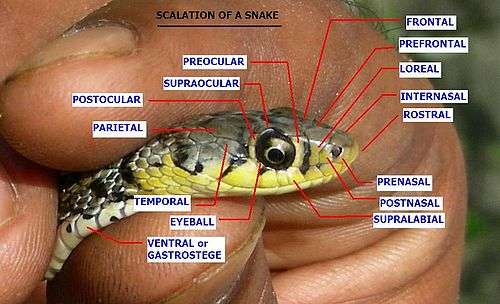
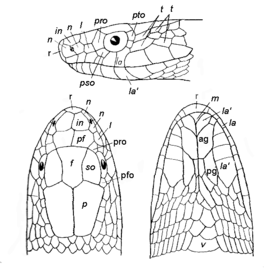
Legend
f – Frontal
in – Internasal
l – Loreal
la – Supralabial
la' – Infralabial
m – Mental
n – Nasal
p – Parietal
pf – Prefrontal
pg – Posterior Genials or Chin shields
pro – Preocular
pso – Presubocular
pto – Postocular
r – Rostral
so – Supraocular
t – Anterior and Posterior Temporals
v – First Ventral
- Scales on the head.
- Rostral.
- Nasorostral.
- Nasal.
- Internasal.
- Brille, spectacle, ocular scale, eyecap.
- Circumorbital.
- Loreal.
- Interorbital, Intersupraocular.
- Frontal.
- Prefrontal.
- Parietal.
- Occipital.
- Interoccipital.
- Temporal.
- Labial.
- Supralabial, Upper labial.
- Sublabial, Infralabial, Lower labial.
- Mental or Symphysial.
- Chin shield.
- Anterior chin shield, Anterior genials.
- Posterior chin shield, Posterior genials.
- Intergeneial.
- Gular.
- Scales on the body.
- Scales on the tail.
Other pertinent terms
- Canthus, or Canthus rostralis, the angle between the supraocular scale and the rostral scale.
- Mental groove.
Taxonomic importance
Scales do not play an important role in distinguishing between the families but are important at generic and specific level. There is an elaborate scheme of nomenclature of scales. Scales patterns, by way of scale surface or texture, pattern and colouration and the division of the anal plate, in combination with other morphological characteristics, are the principal means of classifying snakes down to species level.[26]
In certain areas in North America, where the diversity of snakes is not too large, easy keys based on simple identification of scales have been devised for the lay public to distinguish venomous snakes from non-venomous snakes.[27][28] In other places with large biodiversity, such as Myanmar, publications caution that venomous and non-venomous snakes cannot be easily distinguished apart without careful examination.[29]
The scales patterning may also be used for individual identification in field studies. Clipping of specific scales, such as the subcaudals, to mark individual snakes is a popular approach to population estimation by mark and recapture techniques.[30]
Distinguishing between venomous and non-venomous snakes
There is no simple way of differentiating a venomous snake from a non-venomous one merely by using a scale character. Finding out whether a snake is venomous or not is correctly done by identification of the species of a snake with the help of experts,[31]:190 or in their absence, close examination of the snake and using authoritative references on the snakes of the particular geographical region to identify it. Scale patterns help to indicate the species and from the references, it can be verified if the snake species is known to be venomous or not.
Species identification using scales requires a fair degree of knowledge about snakes, their taxonomy, snake-scale nomenclature as well as familiarity with and access to scientific literature. Distinguishing by using scale diagrams whether a snake is venomous or not in the field cannot be done in the case of uncaught specimens. It is not advisable to catch a snake to check whether it is venomous or not using scale diagrams.[31]:190 Most books or websites provide an array of traits of the local herpetofauna, other than scale diagrams, which help to distinguish whether a snake in the field is venomous or not.[26][32]:52
In certain regions, presence or absence of certain scales may be a quick way to distinguish non-venomous and venomous snakes, but used with care and knowledge of exceptions. For example, in Myanmar, the presence or absence of loreal scales can be used to distinguish between relatively harmless Colubrids and lethally venomous Elapids.[29] The rule of hand for this region is that the absence of a loreal scale between the nasal scale and pre-ocular scale indicates that the snake is an Elapid and hence lethal.[29] This rule-of-thumb cannot be used without care as it cannot be applied to vipers, which have a large number of small scales on the head. A careful check would also be needed to exclude known poisonous members of the Colubrid family such as Rhabdophis.[29]
In South Asia, it is advisable to take the snake which has bitten a person, if it has been killed, and carry it along to the hospital for possible identification by medical staff using scale diagrams so that an informed decision can be taken them as to whether and which anti-venom is to be administered. However, attempts to catch it or kill the venomous snake are not advised as the snake may bite more people.[33]
Cultural significance
Snakes have been a motif in human culture and religion and an object of dread and fascination all over the world. The vivid patterns of snake scales, such as the Gaboon Viper, both repel and fascinate the human mind. Such patterns have inspired dread and awe in humans from pre-historic times and these can be seen in the art prevalent to those times. Studies of fear imagery and psychological arousal indicate that snake scales are a vital component of snake imagery. Snake scales also appear to have affected Islamic art in the form of tessellated mosaic patterns which show great similarity to snake-scale patterns.[34]
Snakeskin, with its highly periodic cross-hatch or grid patterns, appeals to people's aesthetics and have been used to manufacture many leather articles including fashionable accessories.[34] The use of snakeskin has however endangered snake populations[35] and resulted in international restrictions in trade of certain snake species and populations in the form of CITES provisions.[36] Animal lovers in many countries now promote the use of artificial snakeskin instead, which are easily produced from embossed leather, patterned fabric, plastics and other materials.[34]
Snake scales occur as a motif regularly in computer action games.[37][38][39][40] A snake scale was portrayed as a clue in the 1982 film Blade Runner.[41] Snake scales also figure in popular fiction, such as the Harry Potter series (desiccated Boomslang skin is used as a raw material for concocting the Polyjuice potion), and also in teen fiction.[42]
See also
- Anatomical terms of location
- Canthus (snake)
- Fish scale
- Keratin
- Moult
- Reptile scale
- Snake
- Scale (zoology)
References
- Boulenger, George A. 1890 The Fauna of British India. p. 1
- The Snakes of Indiana Archived 2012-04-19 at the Wayback Machine at The Centre for Reptile and Amphibian Conservation and Management, Indiana. Retrieved 14 August 2006.
- Barnes, Thomas G. Snakes: Information for Kentucky Homeowners. University of Kentucky.
- Hartline, PH (1971). "Physiological basis for detection of sound and vibration in snakes". The Journal of Experimental Biology. 54 (2): 349–71. PMID 5553415.
- Cheng Chang; Ping Wu; Ruth E. Baker; Philip K. Maini; Lorenzo Alibardi; Cheng-Ming Chuong (21 May 2010). "Reptile scale paradigm: Evo-Devo, pattern formation and regeneration". International Journal of Developmental Biology. 53 (5–6): 813–826. doi:10.1387/ijdb.072556cc. PMC 2874329. PMID 19557687.
- "integument". Encyclopædia Britannica Online. 2014. Retrieved 23 September 2014.
- Alibardi, Lorenzo (2005). "Differentiation of snake epidermis, with emphasis on the shedding layer". Journal of Morphology. 264 (2): 178–90. doi:10.1002/jmor.10326. PMID 15761820.
- Greene, Harry W. (2004) Snakes – The Evolution of Mystery in Nature. University of California Press, pp. 22–23 ISBN 0520224876.
- Are snakes slimy? at Singapore Zoological Garden's Docent. Retrieved 14 August 2006.
- Herpetology FAQ at San Diego Museum of Natural History. Retrieved 14 August 2006.
- Boulenger, George A. The Fauna of British India... page 234
- Smith, Vol III, p. 6
- Reptiles – Snake facts. Columbus Zoo & Aquarium. Retrieved on 2013-01-21.
- Young Snake Rattles! Ask a scientist! (Zoology archive). Newton BBS, Argonne National Laboratory. Newton.dep.anl.gov. Retrieved on 2013-01-21.
- Rhoades, Dusty. Spring rattles in! Desert USA website.
- Smith, Vol I, p. 30
- ZooPax Scales Part 3. Whozoo.org. Retrieved on 2013-01-21.
- General Snake Information. Division of Wildlife, South Dakota
- Baker, Barry W (2006). "Forensic implications of dorsal row counts on Puff-faced Water-snakes (Colubridae: Homalopsinae: Homalopsis buccata)" (PDF). Herpetological Review. 37 (2): 171–173.
- Smith, Vol III, p. 5
- Smith, Vol III, p. 7
- Identifying snakes by scalation and other details. Wildsideholidays
- Evolution of snakes. Arachnophiliac.co.uk (2007-02-12). Retrieved on 2013-01-21.
- Smith, Vol III, p. 29
- Daniels, J.C. (2002). Book of Indian Reptiles and Amphibians. BNHS. Oxford University Press. Mumbai, pp. 116–118 ISBN 0195660994.
- How To Identify Snakes. kentuckysnakes.org.
- North Carolina State Wildlife Damage Notes – Snakes Archived 2015-01-15 at the Wayback Machine. Ces.ncsu.edu. Retrieved on 2013-01-21.
- Pennsylvania State University – Wildlife Damage Control 15 (pdf). (PDF) . Retrieved on 2013-01-21.
- Leviton AE, Wogan GOU, Koo MS, Zug GR, Lucas RS, Vindum JV (2003). "The Dangerously Venomous Snakes of Myanmar, Illustrated Checklist with Keys" (PDF). Proc. Calif. Acad. Sci. 54 (24): 407–462.
- Resources Inventory Branch, Ministry of Environment, Lands and Parks Resources Inventory Branch for the Terrestrial Ecosystems Task Force Resources Inventory Committee . (1998). Inventory Methods for Snakes Standards for Components of British Columbia's Biodiversity No. 38.
- Thorpe, Roger S.; Thorpe, R. S.;Wüster, Wolfgang & Malhotra, Anita (1997). Venomous snakes: ecology, evolution, and snakebite. Vol. 70 of Symposia of the Zoological Society of London. Oxford University Press, London. ISBN 0-19-854986-5.
- Berger, Cynthia. (2007). Venomous Snakes. Stackpole books. ISBN 0-8117-3412-9.
- Directorate General Armed Forces Medical Services, India. Memorandum No 102 : Snakebite. Undated.pdf available [ online]. Accessed on 21 Feb 2010.
- Voland, Eckart and Grammer, Karl (2003) Evolutionary Aesthetics, Springer, pp. 108–116 ISBN 3-540-43670-7.
- The Endangered Species Handbook – Trade (chapter) Reptile Trade – Snakes and Lizards (section) Archived 2006-03-06 at the Wayback Machine – accessed on 15 August 2006
- Species in Convention on International Trade in Endangered Species of Wild Fauna and Flora (CITES) – accessed on 14 August 2006
- Gabriel Knight – Sins of the Father. Gameboomers.com. Retrieved on 2013-01-21.
- Snake Rattle 'n Roll. consoleclassix.com. Retrieved on 2013-01-21.
- Allahkazam's Magical Realm. Everquest.allakhazam.com. Retrieved on 2013-01-21.
- Monsters/Pets : Reptile. Legend of Mana. qrayg.com
- Encyclopaedia. Brmovie.com. Retrieved on 2013-01-21.
- Quynh-Nhu, Daphne (April 2006). Jade Green and Jade White. teenink.com. Retrieved on 2013-01-21.
Bibliography
- Smith, Malcolm A. (1943) The Fauna of British India, Ceylon and Burma including the whole of the Indo-Chinese Sub-region, Reptilia and Amphibia. Vol I – Loricata and Testudines, Vol II-Sauria, Vol III-Serpentes. Taylor and Francis, London.
Further reading
- Boulenger, George A., (1890), The Fauna of British India including Ceylon and Burma, Reptilia and Batrachia. Taylor and Francis, London.
- Leviton A. E., Wogan G. O. U., Koo M. S., Zug G. R., Lucas R.S., Vindum J. V. (2003) The Dangerously Venomous Snakes of Myanmar, Illustrated Checklist with Keys. Proc. Calif. Acad. Sci. 54 (24):407–462. PDF at Smithsonian National Museum of Natural History, Division of Amphibians and Reptiles.
- Mallow D., Ludwig D., Nilson G. (2003). True Vipers: Natural History and Toxinology of Old World Vipers. Krieger Publishing Company, Malabar, Florida. 359 pp. ISBN 0-89464-877-2.
- Gray, Brian S. (2005) The Serpent's Cast: A Guide to the Identification of shed skins from snakes of the Northeast and Mid-Atlantic States. The Center for North American Herpetology Monograph Series no. 1.Serpent's Tale Natural History Book Distributors, Lanesboro, Minnesota.
External links
| Wikimedia Commons has media related to Snake scales. |
- Are snakes slimy – Singapore Zoological Garden's Docent site
- Microscopic structure of smooth and keeled scales in snakes
- General Snake Information – Division of Wildlife, South Dakota
- Reptiles – Snake facts. Columbus Zoo & Aquarium.
- North Carolina State Wildlife Damage Notes – Snakes
- Pennsylvania State University – Wildlife Damage Control 15 (pdf)
- ZooPax Scales Part 3
- Species in Convention on International Trade in Endangered Species of Wild Fauna and Flora (CITES) – accessed on 14 August 2006.
- The Endangered Species Handbook – Trade (chapter) Reptile Trade – Snakes and Lizards (section) – accessed on 15 August 2006.
